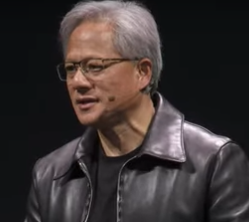NVIDIA Faces Tough Challenge on China
Is the U.S. threatening its future dominance in the AI technology race by severely limiting the ability of American chip companies such as NVIDIA to compete in China?
That’s the question buzzing in the tech industry following NVIDIA’s earnings report last week. While NVIDIA posted solid results despite a ban on sales of its H20 chips to the China market, management said the U.S. is missing out on a $50 billion market opportunity by prohibiting the NVIDIA chips to be sold in the PRC.
Meanwhile, government representatives are taking NVIDIA to task for maintaining research facilities in China and insisting on keeping its options open there—accusations which NVIDIA will have to address in some detail by the end of this month.
Why China’s So Important to NVIDIA
In an interview with CNBC’s Jim Cramer following last week's earnings report, NVIDIA's CEO Jensen Huang described his company's reasons for pursuing the market in China so aggressively:
"[T]he China market is, of course, very large, but it’s also the home of 50 percent of the world’s AI researchers. The platform that succeeds is the platform with the most developers... [T]hat’s probably the most important strategic reason to be in China, because there are so many developers there and because the world is going to adopt technology from one country or another. And we prefer it to be the American technology stack.”
Without NVIDIA chips, China’s developers will turn to homegrown solutions, which are being richly funded by the PRC government, Huang maintains.
“NVIDIA, of course, is the world leader today, but in our absence, if we don't serve a particular market, if we leave a market altogether, there's no question, somebody else would step in,” said Huang during a conversation at the Milken Institute think tank on May 13. “Huawei, for example, is very formidable, one of the most formidable technology companies in the world.”

Jensen Huang, NVIDIA President and CEO. Source: NVIDIA
Huawei's Progress Is Significant
Huawei is indeed on the case. Its recently announced Ascend 910C chip, manufactured by Taiwan Semiconductor Manufacturing Company (TSMC) and China’s Semiconductor Manufacturing International Corp. (SMIC), rivals the performance of the NVIDIA H100 and offers clustering performance that’s better, though requiring more energy consumption. But as observers point out, energy isn’t as as precious to the government of China as it is elsewhere. And Huawei also has been perfecting techniques for stringing multiple GPUs together in parallel to boost performance of supercomputers based on chips inferior to NVIDIA's current product offerings.
Government financial support could boost domestic chip companies' fortunes considerably. According to a Morgan Stanley estimate cited by the Wall Street Journal, China is able to satisfy 34% of its chip demand through domestic suppliers, and the country’s goal is to reach 82% by 2027.
Not So Fast, Say Senators
While NVIDIA argues that Huawei and an assortment of startups threaten its market position, others don’t see that as justifying NVIDIA’s ongoing presence in the PRC.
At least two members of Congress criticize NVIDIA for allowing the Chinese government, which is intimately tied to the country’s technology industry, free rein to appropriate its technologies in ways that could threaten U.S. security.
In a strongly worded letter to CEO Huang on May 28, Senators Jim Banks (R-Indiana) and Elizabeth Warren (D-Massachusetts) questioned the wisdom of NVIDIA’s plan to expand its presence in Shanghai, where NVIDIA reportedly already has about 2,000 employees. The company says it is simply making more room for existing employees, though reports claim it's opening an R&A office to hire more researchers.
“NVIDIA’s great financial and technology success was built on American innovation, American university research funded by taxpayers, and the capital, security, and freedom we provide—not through collaboration with autocracies,” the letter stated.
The senators have given Huang until June 20 to answer a list of questions surrounding NVIDIA’s facility in Shanghai, including queries about who profits from it and why.
Concerns on the part of the U.S. about China were also reflected in comments by Secretary of Defense Pete Hegseth at a conference in Singapore recently.
"Economic dependence on China only deepens their malign influence and complicates our defense decision space during times of tension," Hegseth said.
NVIDIA Digs In Its Heels in China
Despite opposition, NVIDIA is hedging its bets in China. According to a May 29 report in The Information, the company is developing a new chip presently called the B30 specifically for the Chinese market that would pass the current U.S. licensing requirements. The chip uses a high-performance connectivity solution to allow multiple chips to work together in parallel, improving performance—and competing with Huawei’s massive interconnection capabilities.
Input for the new chips could come from researchers at NVIDIA’s new facility in Shanghai. But the design and production of any chips will reportedly stay on U.S. soil—perhaps on the 1 million square feet of manufacturing space NVIDIA has pledged to create stateside.
No Easy Answer
Ultimately, there will be no easy answer to the question about NVIDIA’s participation in the China market.
Clearly, NVIDIA knows that market and has a sense of how it can compete there without exposing its top-end technologies.
And if the U.S. continues to curtail the ability of NVIDIA and other firms to compete in China, it risks ceding the field to Huawei and others in the short term, and to alliances between Huawei and other allies farther out.
Is that a tradeoff worth making? At this point, there is no solution that appeases both NVIDIA and the government.
In his usual style, Jensen Huang offered some math to justify NVIDIA's ongoing presence in China during his call with CNBC’s Jim Cramer:
“Over the course of the next, this four years, the president’s administration, we’re probably talking about a few hundred billion dollars worth of revenues to NVIDIA, probably tens of billions of dollars of taxes, revenues to [the U.S.], thousands of jobs, incredible, incredible opportunity.”
Huang faces the challenge of making his case convincing to government opposers, including Donald Trump himself. So far, trips to Mar-a-Lago and ongoing praise and kudos to the administration haven't helped. Current trade tensions related to tariffs and other factors aren't making the job any easier. But unless he can successfully change the government's opinion, Huang's projections won’t materialize for the good of the U.S. position in the AI race.
Futuriom Take: NVIDIA’s argument for staying in the China market is compelling, but the vendor must make its case more convincingly to the U.S. government that its presence in the PRC does not threaten national security.

